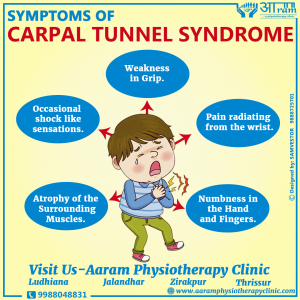 CARPAL TUNNEL SYNDROME
CARPAL TUNNEL SYNDROME
WHAT IS CARPAL TUNNEL SYNDROME?
Carpal Tunnel Syndrome occurs when one of the major nerves to the hand, the median nerve is squeezed or compressed as it travels through the wrist. When pressure is put on the median nerve, which runs through the arm, goes through a passage in the wrist known as the carpal tunnel and ends in the hand. It controls all the sensations of the hand except the little finger.
If the pressure however, continues and is not treated on time, the symptoms and the condition might get worsened and even cause permanent nerve damage.
SYMPTOMS OF CARPAL TUNNEL SYNDROME:
As the pressure and the conditions for carpal tunnel syndrome worsen, you might observe these symptoms:
- Weakness in grip because the muscles present in the hand shrink.
- Pain and cramping radiating from the wrist.
- Numbness in the hand and fingers
- Atrophy of the surrounding muscles
- Occasional shock like sensations
- A loss of strength and coordination in the hand, especially in the usage of thumb
You might first notice that your fingers “fall asleep” and become numb at night. That usually happens in the evening because of the relaxed position of your hand and while sleeping.
In the morning, you may wake up with numbness and tingling in your hands that may run all the way to your shoulder.
Carpal Tunnel Syndrome is known to begin gradually rather than a cause being an injury. Symptoms tend to come and go first, which often leads to neglection. However, in the long run, the symptoms tend to worsen and cause more pain and stay for longer periods of time.
Women are highly likely to develop this syndrome as they have a smaller carpal tunnel in comparison to men.
CAUSES OF CARPAL TUNNEL SYNDROME:
Some medical conditions which are linked to carpal tunnel syndrome include:
- Diabetes
- Thyroid Dysfunction
- Pregnancy
- Menopause
- Fractures
- High Blood Pressure
- Trauma
- Rheumatoid Arthritis
Certain jobs which involve the repetition of the same motion with your arm over a long period of time also raises the chances of getting this syndrome. Some of these jobs include:
- Assembly Line worker
- Sewer or knitter
- Bakers
- Cashiers
- Hair stylists
- Musician
LIFESTYLE CHANGES TO REDUCE THE RISK OF CARPAL TUNNEL SYNDROME:
It all begins with small changes in the work and the living environment.
- Stop straining your wrists at your computer: you must check the ergonomics of your desk and ensure that you’re not straining your wrists or any other joint of your body, any more than necessary.
- Take regular breaks: A repetitive strain injury means you should give your body time to rest. Whether you’re working on a computer or texting up, shake your hands and wrists every regular interval, in order to alleviate the pressure on the median nerve that causes carpal tunnel.
- Relax your hands: Relaxing your grip on devices can avoid the swelling that can lead to carpal tunnel syndrome.
- Sit up STRAIGHT: Slouching puts the shoulders in an unnatural position that shortens the muscles in the neck and the shoulder, compressing the nerves in your neck and triggering swelling and compression of the median nerve.
- Avoid flexing and extending your wrists repeatedly.
- Use a splint or brace that helps keep your wrist in a neutral position.
TREATMENT FOR CARPAL TUNNEL SYNDROME:
It is a gradual process to heal from carpal tunnel syndrome. The symptoms tend to worsen if not paid any caution or care to, that is why it is important to take the advice of a doctor at the early stages only.
The nonsurgical treatment includes:
Bracing or splinting: Wearing a brace or splint at night will keep you from bending your wrist while you sleep.
Nonsteroidal anti-inflammatory drugs (NSAIDs). Medications such as ibuprofen and naproxen can help relieve pain and inflammation.
Activity changes. Symptoms often occur when your hand and wrist are in the same position for too long—particularly when your wrist is flexed or extended.
Nerve gliding exercises. Some patients may benefit from exercises that help the median nerve move more freely within the confines of the carpal tunnel.
Steroid injections. Corticosteroid, or cortisone, is a powerful anti-inflammatory agent that can be injected into the carpal tunnel.
The surgical treatment includes relieving the pressure on your median nerve by cutting the ligament that forms the roof of the tunnel. This, as a result, increases the size of the tunnel and decreases the pressure on the median nerve.
Also, there are many rehabilitation exercises which help reduce the pain and the symptoms of carpal tunnel syndrome.




Comments are closed.